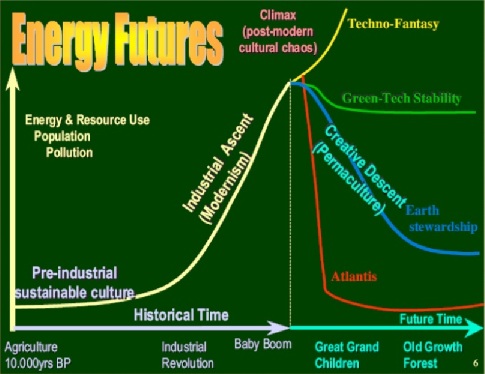*Note from author: The permaculture line—in blue—shows the hope that we can create a gentle descent in population and resource usage, where as the other lines show either continued population growth in the techno- fantasy future, a slight descent in the green tech future or the disastrous descent in the Atlantis future.
One evening my dad, who is a life-long Londoner, told me about a reality TV programme he had seen where a group of people were living as if they were cavemen.
Without any training or advice on hunting and gathering the starved people ended up being forced to eat uncooked worms and arguing about whose hand was where when they snuggled together at night to keep warm. To my city dwelling father this looked like a nightmare.
His view on a “primitive” lifestyle is not uncommon and is often the argument put forward when the progress of mankind is called into question. To me, living in a cave sounds like a great idea, but for many people it seems living in caves brings up images of cold, damp places with a concerning lack of internet connection.
There is no question that we need to drastically cut down on the over-consumption of the planets resources through our luxurious lifestyles. But if we’re going to convince a whole civilisation to “get back to nature” then we’re going to have to come up with something a bit more palatable than uncooked worms.
Permaculture designers have observed that there are three types of stories that people are placing their hope on, or dreading, depending on your outlook. But they have also come up with a fourth option that could be more practical in the long run:
1. The Techno-Fantasy.
This story tells us that someone, somewhere, is hiding the technological solution to all our problems and, any day now, they’re going to whip it out from behind their backs with a resounding ‘ta-da!’- and save us all. It seems to be true that governments have a history of hiding new technologies and suppressing new inventions but to invest in this story too heavily creates a passive population and gives everyone the great excuse to carry on as usual. Also, for me, it conjures up images from films like Bladerunner or Total Recall and of human beings in loin clothes being enslaved by giant robot dinosaurs. *
Admittedly I do have Luddite tendencies – remember I’m up for the caves – but even so, to put all our faith behind new machines seems misguided when it’s the machines that seem to have caused a lot of the problems in the first place.
2. The Green-tech Stability Story.
The second story is similar to the first. This one, however, puts its faith in green renewable energy. If only our governments would invest in solar panels, wind turbines and tidal power etc., then everything would be OK. However, green technologies aren’t free—making them takes enormous amounts of industry to make, including barrels and barrels of oil. It’s a great solution if you’re goal is to become independent from the big energy companies and save money but because of the industry and waste it creates it falters as a long term sustainable solution.
This story also fails to address the real issue—that we are currently using far too much energy.
Faith in the green technology is welcomed by many people because it feels like free energy and we hope that we can carry on as usual—over-using and over-consuming energy—ignoring the fact that most sustainable systems in nature do their best to conserve energy not waste it.
Recently free energy generators, such as the ones invented by Nikola Tesla, have gained popularity as a hopeful solution but we have to consider if humanity is really ready for such a responsibility (or if it ever will be)? Imagine Monsanto or BAE having unlimited energy for the rest of time. Would they use it wisely or would we end up knee deep in mutated plants and carpet bombs?
3. The Atlantis Story.
The third future story is the cave scenario—complete and total social collapse. Whether due to economic meltdown, nuclear war or planetary chaos, the story tells us that we’re going to do something monumentally stupid (we’re not already?) and fling ourselves back into the dark ages.
Some also believe that this is exactly what we need to do to become more sustainable.
If you can handle the dark ages then great! But for most civilized folk it’s an impossible task and this means it’s not a solution (unless we can convince millions of people, pretty soon, to give up their hot running water and electronic devices).
There is however, a fourth story:
4. The Creative Descent Story.
In this story humanity uses observations from nature, design techniques and human ingenuity to create a “designed creative decent,” which gently moves the curve of progress downwards into a more sustainable and cyclical lifestyle. Yes, there will be sacrifices (you might not be able to get apples in February or buy a new top for £2.99) but instead of creating linear systems of production we will find ways to create cycles where energy taken from the environment is given back in equal or greater amounts.
The “creative descent” story says that it’s us as individuals and communities that will take power and responsibility for how we live on this planet. And what’s great is that it’s already happening. Transition Towns and Eco-Villages across the world are creating proactive communities where people are returning to our home, the land, regenerating soils and leaving the place better than it was before.
It’s questionable whether cities can ever be sustainable. But even if you live in a city there are still designs you can try. You could start a guerrilla community garden, throw seed bombs on vacant land or paint lamp posts and bus stops in pretty colours to improve everyone’s mood. You could start urinating in a bottle and spread it around bits of land near you that need more fertility, or spend evenings doing low electrical energy activities like playing board games with the kids or planting a garden.
The key thing is to become a co-designer of your future, the future of your community and the future of the planet—and stop waiting for anything else to save us. Then we might be able to avoid the cave scenario altogether.**
*This was a nightmare I had once about the future.
**You might still find me in a cave.
Relephant:
The Embarrassingly Simple Solution to Climate Change.
~
Author: Suzanne Williams
Editor: Travis May
Photo: Used with Permission











Read 3 comments and reply